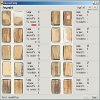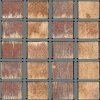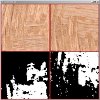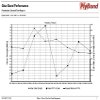Putting plywood bonds to the test
5 January 2005Following the publication of the European standard EN 314: Glue bond quality test and evaluation in 1993, there was evidence of huge variations between laboratories and operators in the visual assessment part of the glue bond test for plywood.
A growing concern about this lack of consistency in testing was the driver behind the EC-funded project, ‘Calibration and testing for the evaluation of plywood glue bond performance in accordance with EN 314-1 and EN 314-2’.
The project, funded by the European Community under the Competitive and Sustainable Growth programme, set out to develop a PC-based training and calibration system for evaluating plywood glue bond performance according to EN 314. The result is two software programs that will work either independently or together.
PlyWoodFail is an automated image analysis system for the evaluation of wood fibre failure (WFF), while PlyBond is a database program to record data and WFF images for internal/external factory production control compliance and for internal/external evaluator training.
Evaluation of plywood glue bond performance is compulsory for CE compliance and marking according to the EU Construction Products Directive (CPD) harmonised standard EN13986: 2002 Wood-based panels for use in construction. Characteristics, evaluation of conformity and marking.
This PC-based system is suitable for use by plywood factories, accredited laboratories and notified bodies involved in the evaluation and certification of glue bond performance, as the project partners intended.
It was also their aim to validate the test and requirement methods set down in EN 314-1 and EN 314-2, along with the procedures for attestation of conformity under the CPD.
The work was broken down into three sub-projects and six work packages, which in broad outline entailed:
- studying the reproducibility and accuracy of PC-based image analysis techniques
- development of a PC-based image analysis system
- developing a database user program, including factory and training/statistics programs for the ongoing development of personnel skills
- testing and evaluating the developed PCbased system with selected samples from industry and laboratories.
One of the main parameters of glue bond performance, apart from the shear strength, is the percentage of wood fibre failure in shear strength samples. EN 314 requires this WFF percentage (WFF%) to be estimated visually, which means a subjective assessment by the evaluator.
The goal of the project, therefore, was to minimise the variation in results from these evaluations, to achieve a unified interpretation of the standard in support of the CPD and the harmonised standard EN13986 for CE marking.
As part of the process, the European market for commercial plywoods was surveyed in order to record combinations of wood species and glue types.
Some 1,300 test pieces, representative of the market, were selected and tested according to EN 314. The WFF evaluations were performed on all test pieces by 13 evaluators from the nine laboratories and the two sub-contracting plywood manufacturers involved in the project.
It is interesting to note that the variation of the WFF evaluation results from the 13 evaluators was in some cases high in relation to the target accuracy in EN 314. As a result of the project work, guidelines for improvement of the process were therefore proposed and included in the revised version of EN 314-1.
PlyWoodFail can be used on a standard PC to perform an automated WFF evaluation. The image analysis is carried out using an EN 314 shear sample set, consisting of 10 test pieces, mounted into a plastic sample holder, which is scanned by a standard office scanner to digitise the images. The wood and glue areas are identified and the area of each is calculated.
The estimated WFF% for each individual test piece in the sample is stored. The WFF% and images can then be exported to the database program PlyBond.
Based on the automated image analysis, an on-screen and on-sample evaluation, it has been shown that the result for the mean WFF% of a shear sample set between the automated image analysis and the harmonized evaluations do not differ by more than 10%. In most cases the difference is less than 5%.
PlyBond contains a Factory module and a Training module.
The Factory module is used to maintain the internal and external factory production control records. A production report can be printed in both tabular and graphical form for the evaluation/attestation of conformity of the product in relation to the bonding class.
The Training module contains verified WFF values for a range of plywoods used in Europe and can be used in the initial training of evaluators and as an ongoing assessment of their capability.
Evaluations require two skills, namely an ability to determine which parts of the test piece have failed in the wood and which in the adhesive and an ability to estimate the percentage of the surface of the test piece occupied by WFF.
Both skills are addressed in the Training module. Moreover, the module will demonstrate to a third party (eg Notified Bodies), via a training report, that laboratory staff have been trained in a uniform manner which corresponds to procedures in other laboratories in Europe.
The software is already in use by EU Notified Bodies and manufacturers involved in the project and will shortly be available for purchase.
Further information on PlyWoodFail and PlyBond is available from the website www.plybond.com, where a demonstration version of the software may be downloaded. For a full project description: http://euplywood.teknologisk.dk.
For further information about wood based panel products and other timberrelated products visit the askTRADA website at www.trada.co.uk.



